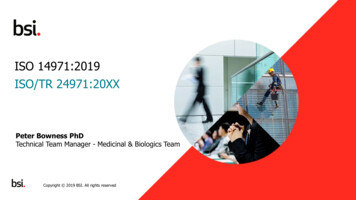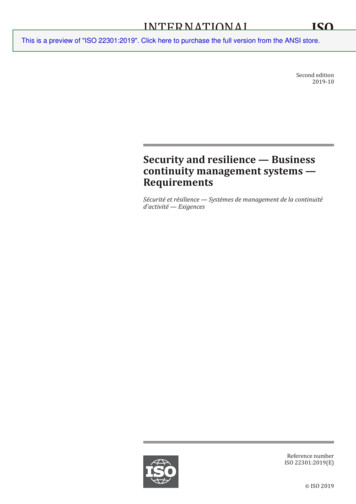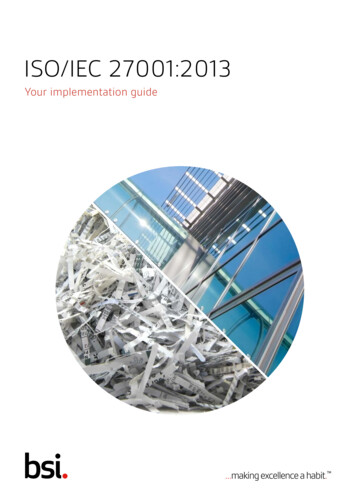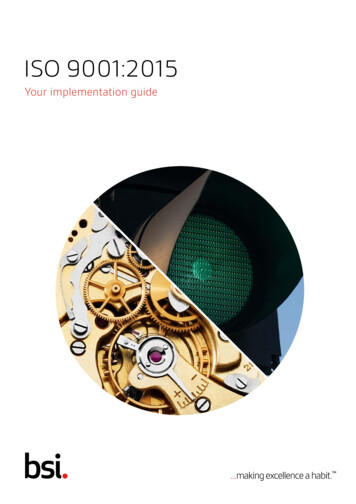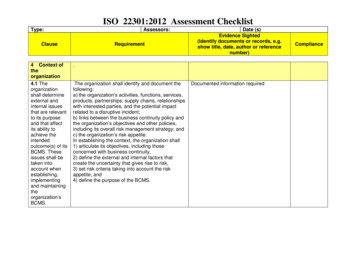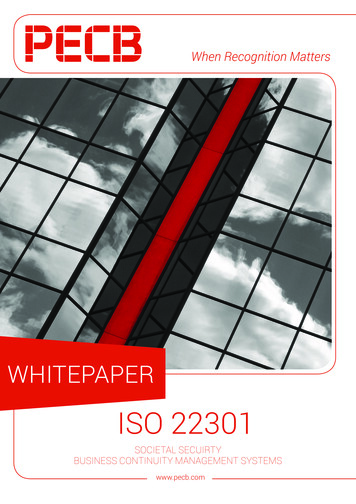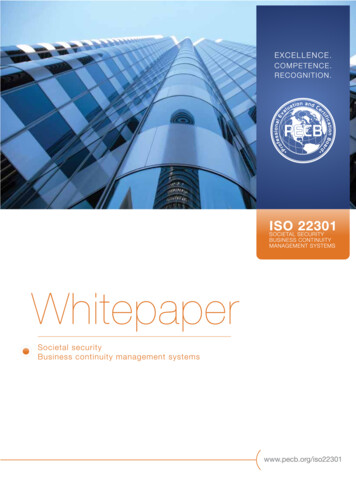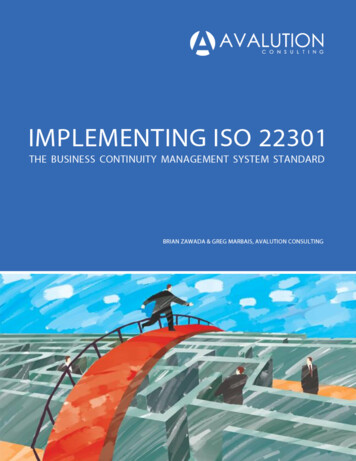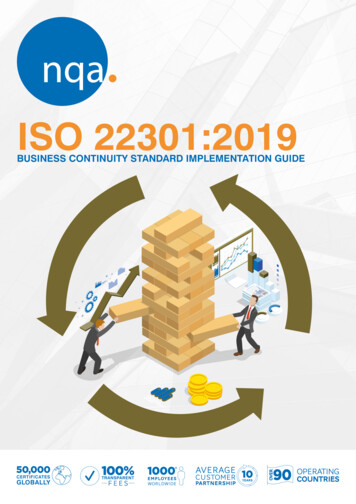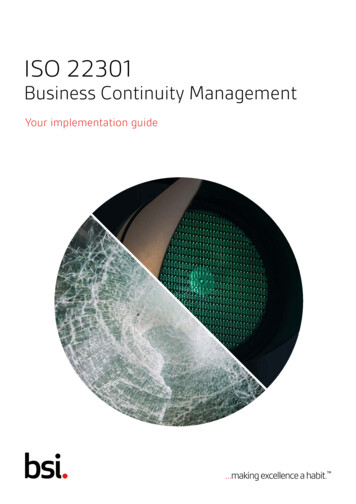
Transcription
ISO 22301Business Continuity ManagementYour implementation guide
Build a robust and resilient organizationwith ISO 22301It’s never been more important to protect yourbusiness from the unexpected. Whether this is frompower cuts, IT system or equipment failure, industrialaction, or natural disaster, you need to make sure yourbusiness is not vulnerable to disruption and you canrecover as quickly as possible.Statistics indicate that 80% of organisations that arefaced with a significant business discontinuity, and donot have in place adequate and appropriate plans toensure business continuity, do not survive the event.Don’t let this happen to you.At BSI we have the experience to help make sureyou get the most from ISO 22301. In fact it was ourexperts who helped shape its precursor, BS 25999-2,in the first place.This guide shows you how to implement ISO 22301,and helps you put in place the measures to protectyour business and help it thrive for the long term. Wealso showcase our additional support services, whichhelp you to not only achieve certification, but also helpyou to continually improve your business.“A disaster can strike an organization at any time.You need to have a process in place that ensures theoperation is able to mitigate the impact and returnto “business as usual” as quickly as possible. For us atVauxhall ISO 22301 fulfills this critical business need.”Phil Millward, GMUK HR Director with overallresponsibility to the Board for the BCMSContents Benefits ISO 22301 clause by clause Top tips from our clients Your ISO 22301 journey BSI Training Academy BSI Business ImprovementSoftware2
How ISO 22301 works and what itdelivers for you and your companyISO 22301 is the international standard that helps organizations put business continuity plans in placeto protect them, and help them recover from, disruptive incidents when they happen. It also helps you toidentify potential threats to your business and to build the capacity to deal with unforeseen events.It helps you to protect your business and your reputation, stay agile and resilient, and to minimize theimpact of unexpected interruptions. Whether your business is large or small, the ability to respond quicklyand effectively to the unexpected is the key to the survival of any organization. This is why having a robustbusiness continuity management system in place, such as ISO 22301, can be considered as one of the mostcomprehensive approaches to organizational resilience.Benefits of ISO 22301*72%82%helps protectour businesshelps managebusiness risk73%56%gives trust inour businessincreases ourcompetitive edge“We recognize [ISO 22301] as part of our overallmanagement of strategic and operational risks, nurturingand enhancing our resilience capability and culture.”Sanjay Verma, Head of Information Security & Compliance, D&B (Australia)*Source: BSI Benefits survey - BSI clients were asked which benefits they obtained from ISO 223013
How ISO 22301 works)ISO 22301 is based on the high level structure (Annex SL) which is a common framework for all newmanagement system standards. This helps keep consistency, align different management system standards,offer matching sub-clauses against thein uOrganization andss Cont ity Managtop-level structure and apply commonemsineits context (4)Buent(language across all standards. It makes4Support&Operationit easier for organizations to incorporate(7,8)their Business Continuity ManagementPlanDoSystem (BCMS), into core businessprocesses, make efficiencies, and get nvolvement from senior management.(9)Plan-Do-Check-Act (PDCA) is the operatingprinciple of ISO 22301. It’s applied to allprocesses and the BCMS as a whole forcontinuous improvement. This diagramshows how Clauses 4 to 10 of ISO 22301can be grouped in relation to PDCA.ActNeeds andexpectations of relevantinterested parties (4)CheckImprovement(10)Some of the core concepts of ISO 22301 are:4ConceptCommentContext of theorganizationThe environment in which the organization operates including internal and externalfactors that can have an effect on your business continuity plans.Interested partiesA person or organization that can affect, be affected by, or perceive themselvesto be affected by a decision or activity. Examples include suppliers, customers orcompetitors. You may refer to them as stakeholders.LeadershipRequirements specific to top management who are defined as a person or group ofpeople who directs and controls an organization at the highest level.Performance evaluationThe measurement of performance and effectiveness of the BCMS, covering themethods for monitoring, measurement, analysis and evaluation, as applicable, toensure valid results.Maximum AcceptableOutage (MAO)The time it would take for adverse impacts to become unacceptable. This is the sameas ‘maximum tolerable period of disruption (MTPD)’.Minimum BusinessContinuity Objective(MBCO)The minimum level of services and/or products that is acceptable to the organizationto achieve its business objectives during a disruption.Prioritized timeframesOrder and timing of recovery for critical activities.Warning andcommunicationActivities undertaken during an incident.IntendedOutcomes
Key requirementsof ISO 22301Clause 1: ScopeThe first clause details the scope of the standard.Clause 2: Normative referencesThis clause provides the normative referencescontained in the standard.Clause 3: Terms and definitionsPlease refer to the terms and definitions contained inISO 22300. This is an important document to read.Clause 4: Context of the organizationThis clause is a good starting point to approach thestandard as you need to decide on the context of yourBCMS and how your organizations’ strategy supportsthis. This means that you need to identify how yourorganization sits within its environment.You will need to identify external and internal issuesthat are relevant to the purpose of the BCMS and howthey relate to its expected outcomes.Then you’ll need to identify your relevant internal andexternal “interested parties” (or stakeholders) who arerelevant to the BCMS.You’ll also need to decide what is covered by businesscontinuity and just as importantly what isn’t. Thismeans that you will need to consider your appetitefor risk and what the relevant legal and regulatoryrequirements for your organization are.You will be required to communicate this scopeto relevant interested parties both internally andexternally so they are aware of your BCMS and how itis relevant to them.Clause 5: LeadershipThis clause focuses on the role and requirements of topmanagement, which is the group of people who directand control your organization at the highest level inrelation to the BCMS.Top management must show their commitment tothe BCMS in a number of different ways. Firstly, byensuring the BCMS is compatible with the strategicdirection of the organization. Secondly, they need toshow how your BCMS requirements are integrated intoyour business processes. And lastly by communicatingthe importance of an effective BCMS and conformingto the BCMS requirements.Policy creation and communication is a reallyimportant part of this clause. You will need to ensurethat your business continuity policy is appropriatefor your organization and that it meets relevant legaland regulatory requirements. It should also be madeavailable to all interested parties you have identified.Top management should assign responsibility for theestablishment, implementation and monitoring of theBCMS. And finally, you will also need to show how youcontinually improve the BCMS.5
Clause 6: PlanningClause 7: SupportThis clause relates to establishing the strategicobjectives and guiding principles of the BCMS as awhole. It requires you to consider the risks from yourBCMS not being successfully implemented.This clause is all about the resources that are requiredto establish, implement and maintain an effectiveBCMS. You‘ll need to make sure that people arecompetent in terms of education, training, awarenessand experience. You will also need to consider thecommunications with interested parties and yourrequirements for document management.This means that you need to make sure youunderstand both the internal culture and theexternal environment in which your organizationoperates and also what the likely barriers may be inpreventing your BCMS from being effective.You will be required to clearly define your businesscontinuity objectives and show that you haveplans to achieve them. Your objectives should bemeasureable.You will also need to decide on the minimum levelof products and services that will be acceptable toyour organization in order to achieve your businessobjectives. (This links back to the scope that youhave defined in clause 1).You’ll need to decide who will be responsible fordelivering the objectives, what will be done in whattimescale, what resources will be required, and howthe results will be evaluated.6Taking into consideration the increased use ofsubcontractors in today’s business environmentthis clause requires you to make sure that everyoneunder the control of your BCMS understands theircontribution to its effectiveness and the implications ofnot conforming to it. Critically, they must understandtheir role at the time of a disruption. You will also needto show how you respond to communications frominterested parties.It is crucial that your organization fully documents allelements of the BCMS and these documents must bemaintained, controlled, and stored appropriately. (Howyou do this is up to you, but it must be effective foryour organization).
Clause 8: OperationClause 9: Performance evaluationIn this clause you must show how the processesthat you have developed to manage the risks to theBCMS are being correctly implemented. This includesany processes that may have been subcontracted oroutsourced.This clause covers the maintaining and reviewing of theBCMS so it is kept relevant and up-to-date. This is sothat you have the metrics in place to ensure that youeffectively manage the BCMS and continually improve.You need to define the order and timing of recoveryfor critical activities that support your organizationsproducts and services. This includes deciding on what aminimum acceptable level is.You need to be aware that there may be certain financialor governmental obligations that require communicationand that there may be a societal need to share certaininformation in the event of a disruption. Your processshould focus on minimizing the consequences of adisruption.You will also need to have documented proceduresto restore and return business activities from thetemporary measures adopted to support normalbusiness requirements after an incident.Although you do not need to have an approved exerciseprogramme in place to check the effectiveness of yourBCMS, you do need to have exercises based on anappropriate range of scenarios. Lastly, you will need topromote continual improvement of the BCMS.After an internal audit, the management responsible forthe area being audited must ensure that any correctionsor corrective actions that have been identified are carriedout without delay.This clause also covers management review. You willneed to provide information for review on the trends in;nonconformities and corrective actions, monitoring andmeasurement evaluation results, and auditing results.Finally, there is a requirement for your organization tocommunicate the results of the management review torelevant interested parties and take appropriate actionsrelating to those results.Clause 10: ImprovementThis clause is all about making your BCMS as effective asit can be to show how you are proactive in managing it.You are required to show how you continually improveand enhance the performance of your BCMS to ensureit is robust and relevant. This may be, as a result ofidentifying potential threats or risks from any internal orexternal factors that are relevant to your organization.You will also need to show how the BCMS has beenupdated in response to any non-conformities orcorrective actions.7
Top tips on making ISO 22301effective for youEvery year we help tens of thousands of clients. Here are their top tips. Top management commitmentis key to making this a success“The earlier that organizations talk to seniormanagers, the better it will go for them sohave those discussions early”.John Scott, Overbury, leading UK fit-out andrefurbishment businessKeep staff informed of what’s going on, createa team or assign a champion, as this willincrease motivation. This could include a wellcommunicated plan of activities and timescales.“When we decided to implement the newstandard, we assigned an internal championof the standard inside the organization”.Think about how different departmentswork together to avoid silos. Make sure theorganization works as a team for the benefit ofcustomers and the organization.“With ISO 22301 in place, we are all talkingthe same language about the business. We allunderstand what is meant by best practices andwe are better able to deliver on our customers’expectations even during an impactful businessevent”.Ronald Tse, Ribose, Hong Kong based cloud servicesproviderDan Nickel, Ciena, US based network solutions providerReview systems, policies, procedures andprocesses you have in place – you may alreadydo much of what’s in the standard, and make itwork for your business.“The BCM system is a great reassurance. It hasenabled us to make plans to mitigate problemsquickly if they occur– for example, to identify asecond water supply and provide electricity backup – things we wouldn’t have done otherwise”.Andy Drummond, Lettergold Plastics Ltd, UK engineeringcompanySpeak to your customers and suppliers.They may be able to suggest improvements andgive feedback on your service.“They [customers] know we have a solidframework for service continuity and ability torestore all services to business as usual operationin th
ISO 22301 is the international standard that helps organizations put business continuity plans in place to protect them, and help them recover from, disruptive incidents when they happen. It also helps you to identify potential threats to your business and to build the capacity to deal with unforeseen events. It helps you to protect your business and your reputation, stay agile and resilient .File Size: 1MBPage Count: 12Explore furtherSecurity and resilience — Business continuity management .dri.caISO - ISO 22301 - Business continuitywww.iso.orgIMPLEMENTING ISO 22301: THE BUSINESS CONTINUITY MANAGEMENT .webstore.ansi.orgBS EN ISO 22301-2019 Security and resilience. Business .www.nobelcert.comISO 22301 - Business continuitywww.iso.orgRecommended to you based on what's popular Feedback
